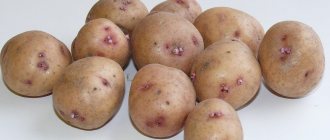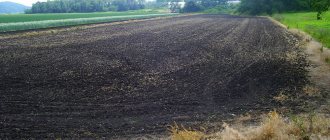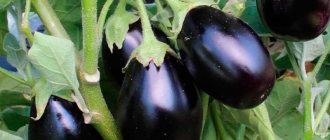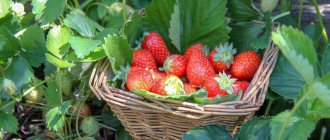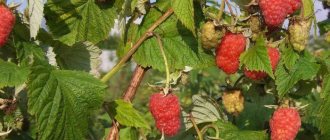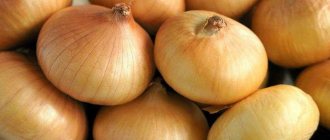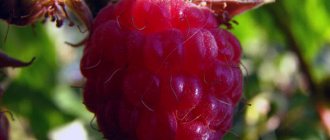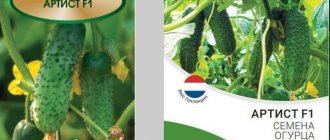Composition of tobacco dust
The substance is used as a source of useful elements. The product is sold in garden stores in plastic packages weighing 260 g, as well as in paper kilograms. The substance contains:
- from 2 to 5% nitrogen;
- 1-3% potassium;
- up to 2% phosphorus;
- magnesium.
Due to its rich composition, tobacco dust is used in gardening as a natural plant fertilizer.
Tobacco serves not only as a fertilizer, but also as a means of pest control.
Release forms
The use of tobacco dust in gardening and horticulture is carried out in the form of:
- Fine dry powder for filling the soil during spring digging, pollination, preparing decoctions and tinctures.
- Crumbs - for filling into the soil before winter, preparing decoctions and tinctures, as well as fumigation with smoke from a smoke generator.
- Self-prepared liquid forms from purchased medications.
- Smoke bombs for processing crops in closed soil.
The commercial preparation of tobacco dust (item 1 in the figure) is most often produced in a 1:1 mixture with slaked lime; this makes the dust itself more sticky and caustic for pests (tobacco dust is a contact poison), and less volatile for people and thus safer. If pest control is in the foreground, and what will happen with fertilizer, a mixture of tobacco and shag dust (item 2) in the same proportion without additives will be more effective, but it must be used with all the necessary precautions and self-defense, see below.
Preparations based on tobacco dust for treating gardens and vegetable gardens
The drug Tabazol (item 3) is a more preventive biocide, but it is a good fertilizer “with a long-range view” - it increases the activity of soil-forming bacteria and saturates the soil with microelements. Tabazol is a mixture of tobacco dust with plant ash 1:1 (for normal soils) or with ash and slaked lime 1:1:1 for acidic soils.
The action of Tabagor (item 4) is generally the same as Tabazol, but as a fertilizer it works faster, because is a mixture of tobacco dust and white mustard. Mustard is known to be an excellent organic fertilizer and as such is a generally recognized green manure crop. As a spice, mustard is attractive to ants (see below) and some leaf-eating pests. For example, in general, the preventive and fertilizing Tabagor is very effective against cabbage pests, see video:
Video: controlling cabbage pests using tobacco dust
Note: tobacco dust is also included as a component in a number of complex agrochemical preparations (items 5, 6, etc.). Of these, on a small well-groomed plot of up to 20-30 acres and, especially, on a very small one (6-12 acres) under polyculture (dacha, homestead), the Kazakh Nasvay has recently proven itself very well (see figure on the right). Its regular use makes it possible to maintain the fertility of intensively used land year after year, reducing by half or three times the costs of such rather expensive soil reclamation means as humates.
How to choose the main component
There is nothing in purchased preparations with tobacco dust (except for complex specialized ones) that cannot be prepared with your own hands at home: the components can be purchased separately and mixed in dry form, and then, if necessary, prepared from them in liquid forms, see below. This, however, requires a separate ventilated room: tobacco dust in large packages is not plasticized or passivated; It is very, very necessary to protect your respiratory organs and skin from it.
The use of homemade mixtures with tobacco dust is all the more justified in large areas if there is a separate ventilated room for preparing mixtures - tobacco preparations for agricultural use in bags are packaged from 260 g to 1.5 kg, which will be expensive per hectare. You just need to choose the right main component – the dust itself. This is not difficult: in large packaging, tobacco dust is sold in bags, one of which will probably be opened in the warehouse; in medium and small for self-cooking - in plastic bags (on the left in the figure). Both there and there it will be immediately clear what to take.
It is best to buy dust already mixed with lime: it is reddish, lumpy, does not generate dust and can be taken with your fingers in a pinch, pos. 1 in Fig.:
Forms of release of dry tobacco dust for independent preparation of preparations from it
Shag dust is slightly greenish with yellowish tint (pos. 2). Shag dust is not mixed with lime, and it is taken “loosely” with a pinch: it pours out from slightly clenched fingers. Tobacco crumbs are not a production waste, but waste from cigarettes torn during stuffing, unraveled cigars and substandard pipe tobacco; its color is the same as smoking tobacco (item 3) and it is taken in the same way: not in a pinch, but not completely scattered.
Tabazoles can also be purchased not packaged, but by weight; it will cost much less than drugs in packages. Here you need to look at what kind of ash the base is mixed with: the best loose Tabazol is gray (item 4), on stove wood ash. The “appetizing” brown tabazol (item 5) contains ash from herbaceous annuals (most often sunflower), and is less effective as a fertilizer.
Using the preparation for fertilizer
When tobacco waste is added to basic agricultural products, it can increase productivity by 40%, improve the quality of fruits, and increase the biological activity of the soil. It is indicated to use the substance to prevent damage by harmful insects and activate beneficial bacteria.
In the garden and vegetable garden this product is fertilized as follows:
- add to the soil when digging in an amount of 2-4 g per 1 m2;
- 500 g are added to the bottom of planting holes for trees and shrubs;
- before sowing the lawn, spread it over the surface, followed by loosening and watering;
- before winter, mix with potassium and phosphorus preparations;
- in spring they are used together with nitrogen supplements.
Use as fertilizer
Tobacco dust contains mineral elements that plants need. Its chemical composition accelerates plant growth, improves the quantity and quality of fruits. The powder can be applied to the soil during its preparation, during sowing or planting crops.
See also
How to quickly make compost from sawdust with your own hands and use fertilizerRead
So, for example, when planting trees or shrubs, add 1 or 2 cups of dust to each planting hole. When preparing land for planting vegetables or sowing lawn grasses for each square. m. add 20 g of the drug. To ensure uniform distribution of the powder in the soil, the soil must be thoroughly mixed after application. When used in spring, it is recommended to add dust to nitrogen-containing fertilizers. When applied in the fall, add to potash mixtures.
You can use tobacco dust not only as a top dressing, but also as a main fertilizer. Application should be done less frequently - once every 3 seasons, but with an increased amount of product - 40 g per square meter. m.
If tobacco dust is used to feed indoor flowers, then it is added to the substrate in a volume of 0.5 tsp. per 10 liters of soil. The mixture is filled into pots when replanting plants.
Pest protection
Tobacco is a natural insecticide that successfully replaces pesticides. The active ingredient is nicotine, which destroys copperheads, aphids, leaf rollers, flea beetles, and ants. Below are the main methods of using tobacco dust.
Pollination
For this method, dust is suitable either on its own or mixed with ash or lime in equal quantities. It is allowed to treat plants both in the garden and in the greenhouse; consumption is 10-20 g per 1 m2.
It is recommended to practice this method no more than twice a season.
Spraying with infusions and decoctions
This is a convenient and common way to kill insects. Irrigation is carried out 2-3 times with an interval of half a month.
After spraying, the greens are not consumed as a food product.
Tobacco dust decoction
Tobacco is mixed with water in a ratio of 1:10 and simmered over low heat for 30 minutes, restoring the volume of liquid as it boils. If you add onion peels to the dust, the product will also be suitable for killing leaf-eater caterpillars. The broth is infused for 24 hours, then filtered and diluted with water in a ratio of 1:3. Before irrigation, 40 g of liquid soap, soap shavings or shampoo are added to the solution bucket.
Tobacco dust, use in gardening. How to prepare a decoction of tobacco dust
In order to prepare a decoction based on tobacco dust, you need to purchase two hundred grams of the main ingredient. For this amount you need to spend about two liters of water. The mixture must be boiled for two hours. The fire should not be strong. Add additional water from time to time.
Then close your finished decoction and leave it to brew for a couple of days. Before use, strain this composition and dilute with ten liters of water. This product is used to spray various crops against pests.
In order for the product to remain on the foliage of plants for a longer time, it is necessary to add a soap-based solution to the decoction of tobacco dust. Laundry soap, liquid soap, or laundry detergent are well suited for these purposes.
The amount of such solution should not be large. If you use liquid soap for this, then half a tablespoon will be enough. Sometimes they use inexpensive shampoo. Its consumption is usually one tablespoon. If you add a similar solution to your decoction, the effect will be more stable. Exposure to tobacco dust will be longer.
Many gardeners use tobacco infusions. They are even easier to prepare than decoction, since there is no boiling process. To make this product more effective, you can add wood ash to it. The infusion is best used fresh.
For processing, you need to choose the morning or evening. At this time, the sun's rays are not as aggressive, and the risk of your plants getting burned will be minimal.
Why should tobacco infusion be used fresh? The fact is that over time, the infusion loses its properties, for the sake of which, in fact, everything was started. It becomes less effective against harmful insects.
Treatment with this product is usually carried out two to five times a year. How often this procedure needs to be done must be decided based on the degree of damage caused by harmful insects.
What insects is the product most effective against?
A natural insecticide is capable of destroying the following types of insects:
- Fleas die from pollination. The procedure is carried out 2-3 times every month and a half.
- To destroy onion and cabbage flies, powder the root collar of plants, using 10 g per square, twice per season.
- The plant is destroyed by spraying trees at the stage of bud formation or using smoke after flowering.
- Aphids die from pollination with a dry preparation or from spraying with a decoction. Treatments are carried out within 7-10 days.
- Gooseberry moths, raspberry beetles and spider mites are controlled by spraying during bud break.
Who to use it against?
Due to the above circumstances, tobacco dust insecticide is quite selective. Therefore, you must first decide who is harming and prepare a drug for a specific pest.
Tobacco dust is most effective against cruciferous pests such as the jumping bug, cruciferous flea beetle and cabbage fly. But the methods of their attack on plants are different, therefore the methods of combating them with tobacco dust are different.
Cruciferous flea beetle
Against the cruciferous flea beetle (see figure on the right) prepare a dry mixture of tobacco dust, slaked lime, wood ash and phosphate rock 3:1:1:1. If the mixture is made on the basis of ready-made tabazol, you need to mix the components 1:1:1:1 and add 2 parts of tobacco, or, better, tobacco-shag dust 1:1. Plants are pollinated in the morning from a garden pollinator at the rate of 20 g (1/8 cup)/1 sq. m of leaf area. For more information on fighting cruciferous flea beetles using tobacco dust, see the video:
Video: tobacco dust against cruciferous flea beetle
Note: the garden pollinator is not cheap, it produces a fairly strong stream, and the consumption of the drug will be exceeded. It’s okay, but in order to waste less powder, if you have a car compressor, you can make something like a sandblasting machine from propylene water pipes, and pollinate from it. You can even without a compressor - use the “tobacco jet” from a large medical syringe for vaginal irrigation. And there is no need to remove the tip from it - it has grooves through which air will pass into the hose and the apparatus. You just need to place a ball check valve at the air inlet of the pollinator, and immediately in front of it - an air petal valve so that the syringe can suck in clean air.
Cabbage fly
Against cabbage fly (see picture on the right) you need a mixture of tobacco or tobacco-shag dust with lime 1:1. In the evening, the soil around the plants is powdered with it, extending 4-5 cm beyond the contour of the bush. Consumption - 20 g per 1 sq. m. m of land. Instead of dusting agent, you can use a fine sieve. After 2 weeks, dusting is repeated, but no more! The maximum frequency of treatment with any tobacco dust preparations is 2 times a season!
Against aphids of all types (top row in the figure, except for the right fragment) and thrips (bottom in the figure below), tobacco dust or tobacco-shag (from thrips) dust without impurities is used in the form of an infusion or decoction, see below. The infusion is more effective because retains more active ingredients, but is prepared in 2-3 days, not hours, like a decoction. The preparation is sprayed on plants according to the usual scheme (fruit trees - before the buds open): preferably in the evening; the stream is “foggy”, very shallow. Application rate – before drizzle settles on the leaves; As soon as the first droplets have formed, that’s enough. Vegetables are processed no earlier than 2-3 weeks before the start of harvesting the first fruits.
Aphids, whiteflies (top) and thrips (bottom) on plants
Tobacco-shagage infusion of beret and tobacco thrips, lower right in Fig. The fact is that the concentration of nicotinoids in tobacco during its fermentation and drying for smoking increases several times. A pest from tobacco infusion will face the same end as the binge drinkers who drank the infamous “Hawthorn” instead of the normal “breech”. But against whiteflies (top right in the figure), a colony of which an inexperienced person without looking closely can mistake for aphids, tobacco preparations (like many other contact insecticides) have little effect: these pests are well protected from them by a “cloak” of rather dense wings. Tobacco against whiteflies is effective only as a preventive fumigation of premises for indoor crops, see below.
Note: after flowering, it is advisable to fumigate fruit fruits to guarantee, as against the honey worm, see below.
One of the most dangerous fruit pests is the caterpillars of codling moths:
The codling moth butterfly and its caterpillar - “worm”
It is impossible to lime the “worms” that have already penetrated into the fruit without making the crop unsuitable for food. Adult codling moths (adult flying and breeding individuals) are clearly visible only in pictures (position 1 in the figure), but in nature they are well camouflaged and well protected (position 2). Therefore, tobacco fights the codling moth in the form of a strong infusion of pure dust: 150 g of the component is poured into 1 liter of hot, still very steaming (70-80 degrees) boiled water and left for a day in a covered container in a dark place. Then the infusion is filtered into a plastic bucket, topped up with water and sprayed immediately - the finished product is not stored! The garden is treated twice: the first time 2 weeks before flowering; secondary - immediately after the separation of the buds, i.e. after they emerge on the peduncle (on the style) and the receptacle is released on them, but before they begin to bloom. It is necessary to spray the entire tree or bush, because... codling moths lay eggs in cracks in the bark near developing fruits.
Fruit crops from copperheads (see figure below) are sprayed with the usual infusion or decoction of tobacco dust, see below. Processing time – separation of buds; the scheme is normal. To guarantee, after the formation of ovaries begins, choose a quiet, warm, not hot day (or evening) and fumigate the plantings, see below.
Insect sucker
Tobacco dust is an effective remedy against all types of slugs that damage the garden (see next figure), but subject to 2-fold treatment: the first portion causes a protective reaction in the slugs in the form of copious mucus secretion and shedding of the mucous membrane; this is to some extent analogous to the nausea of a person who smokes for the first time. But the period of adaptation to nicotinoids in slugs, like in humans, is zero: already the second dose goes “with a bang,” but now, unlike us, with a quick, inevitable end for the mollusk.
Slugs of different types
Tobacco dust mixed with slaked lime 1:1 is used against slugs - this mixture dries out soft-bodied slugs and reduces their ability to form mucus. The soil around the plants is dusted, as against cabbage flies, at the rate of 25-30 g per 1 square meter. m of soil. Dusting is carried out in calm, warm and humid weather, favorable for slugs in the evening, and repeated the next day or day after tomorrow. If particularly resistant individuals are then noticed, the treatment is repeated after 2-3 weeks.
Tobacco dust against ants is used in two ways, because... There are two groups of these garden and city pests: some graze aphids, while others gnaw on fruits. Grazing ants can also be fruit-gnawers of soft, juicy fruits with thin skin (for example, raspberries); They live, as a rule, outside the site. Fruit-eating ants (see the figure on the right) are most often earthen and dig their anthills in the area.
Pest ants gnawing fruits and their anthill
Shepherd ants are fought with tobacco in the same way as cabbage flies, by sprinkling tobacco dust on the ground around the affected plants. At the same time, it is necessary to fight against aphids, but you should not completely harass the shepherd ants - they are useful in the wild. But you have to fight fruit-eating ants mercilessly. Moreover, for example, The yellow garden thief ant and the pharaoh ant, as modern research has shown, are carriers of a number of infectious diseases.
Tobacco dust powder against earth ants
So, against ants gnawing on fruits, it is highly advisable to make a mash from tobacco dust (preferably from Tabagor, see the figure on the right), find a nesting place for pests (position 2 in the figure above) and at night, when the insects are sleeping, fill the anthill and the ground with the mash Around him. Tobacco dust mash against ants is a cooled decoction.
Gardeners, flower growers and gardeners know how difficult it is to fight spider mites. Their pioneer individuals-first settlers (position 1 in the figure on the right) are defenseless, but single and unnoticeable due to their tiny size - 0.05-1 mm. And when the colony is formed and stretches a cobweb shield over itself, it becomes vulnerable only to strong pesticides and acaricides that saturate the plants.
Spider mites on plants
In addition, spider mites, pests of fruit trees, almost always settle on the undersides of leaves (pos. 2), where the stream from the sprayer does not reach well. Therefore, tobacco dust can also be combated against spider mites in two ways: by spraying, as against thrips, and, after 1-2 days, by fumigation. Treatment sessions are carried out twice: when the buds separate (from the pioneer individuals) and when the plants fade.
Note: it is better to fumigate plants against ticks using Hephaestus smoke bombs, see below. With checkers you can fumigate not only trees, but also low berry bushes.
Precautionary measures
Nicotine has a harmful effect on humans, therefore, when working with tobacco dust, safety rules must be followed:
- To prevent tobacco dust from entering the respiratory tract, you should use a respirator or a cotton-gauze mask.
- The skin of the hands is covered with mittens.
- To protect your hair, you need a hat.
- When fumigating, a gas mask is the best protection. Another option is to move away a sufficient distance.
- Work clothes must have long sleeves and trousers untucked over shoes.
- Store your work suit in a non-residential area.
- When fumigating greenhouses, you must not be inside.
- Keep the drug in a tightly closed container.
Children must be especially protected from exposure to dust.
Both inhalation of smoke during fumigation and absorption of tobacco dust through the skin can lead to tobacco addiction!
Gardeners who have abandoned the use of chemicals appreciate tobacco as an insecticide and fertilizer. They fell in love with this product for its naturalness, accessibility and low cost.
Tobacco solution
The article talks a lot about spraying plants with tobacco solution. How to cook it? Mix 1/2 cup of tobacco ash with 1 liter of water.
Boil the resulting mixture for 30 minutes, adding water if necessary. Leave the solution for a day, then add another 1.5 liters of water and add a little liquid soap.
There is an easier option. Pour 1/2 cup of tobacco dust into 1 liter of boiling water, leave for a day, add liquid soap. Plants are treated no later than two weeks before harvest.
AllaAuthor of the article
Did you like the article?
Share with your friends:
Comments (1)
- Sergey Sep 24, 2021 at 10:44 pm
Do you not distinguish between the words dust and ashes? Feeling. that you just learned to write. Learn to do it correctly and competently.
Answer

